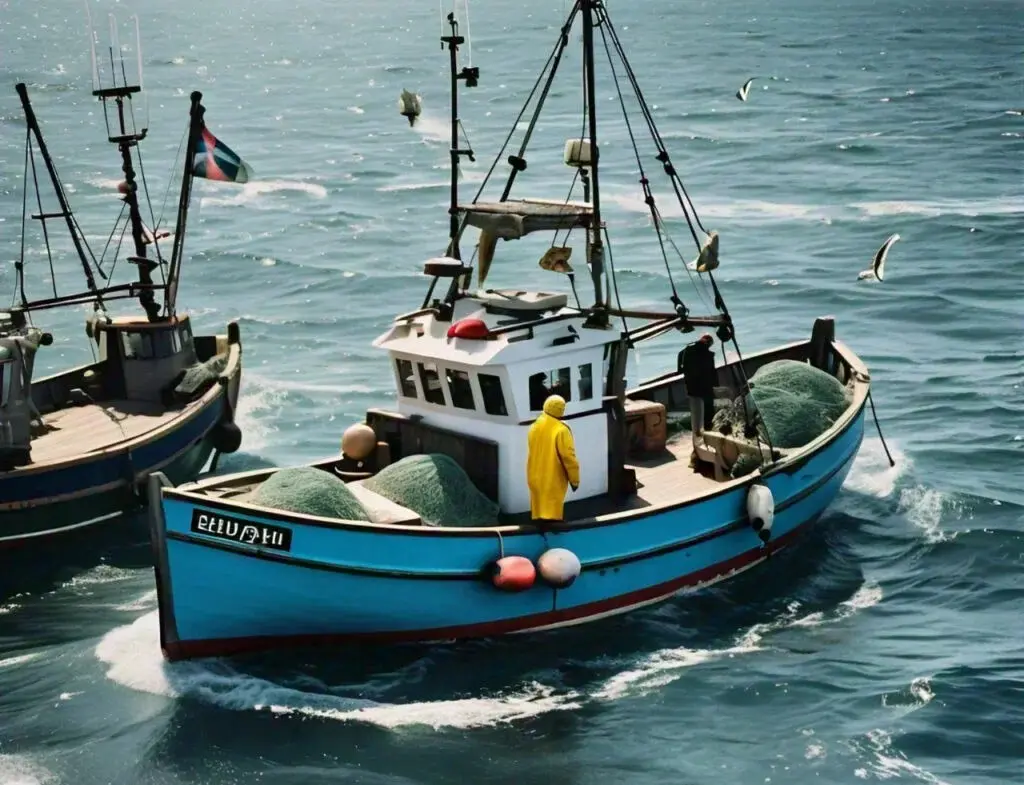
Understanding how to overtake a fishing boat is vital for anyone who enjoys boating. Fishing boats, whether commercial or recreational, have specific operating patterns and potential hazards that other boaters should be aware of. This guide provides essential advice on how to overtake a fishing boat safely and respectfully, ensuring a safe and enjoyable experience on the water.
Understanding Fishing Boats and Their Operations
Types of fishing boats
Fishing boats come in several types, each designed for specific fishing methods:
- Trawlers: These are larger boats that drag nets along the seabed to fish. They often move slowly and have full equipment extending from the ship.
- Longliners: These boats use longlines with baited hooks for fishing. The lines can be several kilometers long and present significant danger if crossed.
- Sport Fishing Boats: Small pleasure boats used by individuals or groups for fishing. These boats may have lines and lures that may extend some distance from the boat.
Common fishing activities
Fishing boats often engage in activities that require them to move slowly or remain stationary:
- Drag: Dragging nets in the water to fish.
- Setting traps: Setting traps on the seabed to capture lobsters, crabs, or other marine life.
- Angling: Use long lines with multiple hooks to fish.
Understanding these activities will help you anticipate the movements and potential dangers associated with fishing boats.
Essential Tips for Safely Passing a Fishing Boat
Keep a safe distance
Always stay a safe distance from fishing boats. This precaution allows you to avoid entangling your boat in fishing gear that may extend far from the boat. A safe distance also minimizes the risk of collision.
To slow down
Reducing speed when approaching a fishing boat is essential. Reducing speed not only shows respect but also reduces wake, which can disrupt fishing operations and create unsafe conditions for the fishing vessel.
Communicate clearly
Use beeps or a VHF radio to communicate with the fishing vessel. A few brief blasts of the horn can signal your intentions, or you can radio the fishing boat to make sure they are aware of your presence and your plan.
go to the port
Whenever possible, pass fishing boats on their port (left) side. This is a common maritime practice that helps avoid encountering your fishing gear. Always observe the ship’s movements and follow the crew’s signals.
Avoid crossing closely
Never cross behind a fishing boat. Fishing gear can extend behind the boat and crossing too close can lead to dangerous entanglements. Make sure there is enough space before crossing its wake.
Recognizing Signals from Fishing Boats
Flags and beacons
Fishing boats often display specific flags and markers indicating that they are engaged in fishing. For example, a red and white flag indicates that a diver has fallen, while other markers may indicate the presence of fishing gear.
Lights and shapes of the day
At night or in low visibility conditions, fishing boats use lights to indicate their activities. Red lights on white indicate a boat dedicated to fishing. During the day, black shapes, such as cones or balls, can also indicate fishing operations.
Legal and Safety Considerations
Maritime laws
Familiarize yourself with local maritime laws and regulations regarding the passage of fishing vessels. These laws are designed to protect both fishing operations and other boaters, ensuring safe and efficient boating.
Respect for fishermen.
Respect the work of fishermen. Fishing is often a livelihood and its operations are vital. By passing respectfully and safely, you contribute to a cooperative and courteous boating environment.
Practical Scenarios and Solutions
Upstream approach
If approaching a fishing boat from upstream, consider the current and the potential drift of the fishing gear. Maintain extra distance to account for any unexpected movement of the equipment or the boat itself.
Navigating busy waters
In busy fishing areas, several boats may be fishing. In such scenarios, proceed slowly, communicate clearly, and be especially vigilant about maintaining a safe distance from all fishing activities.
Advanced Tips for Experienced Boaters
Use of navigation aids.
Use navigation aids such as GPS and marine radar to better understand your surroundings and the position of nearby fishing boats. These tools can help you navigate safely even in poor visibility conditions.
Understand weather patterns
Weather can have a significant impact on sailing conditions. Strong winds, heavy rain, or fog can reduce visibility and increase the risk of a collision. Always check the weather forecast before leaving and be prepared to adjust your route to ensure your safety.
Practice situational awareness
Always be aware of your surroundings. Keep an eye out for fishing boats, other vessels, and any obstacles in the water. Scan the horizon regularly and use all available tools to maintain situational awareness.
Conclusion: Ensuring Safe and Respectful Boating
Understanding how to pass a fishing boat safely is a fundamental aspect of boating. By following these guidelines – maintaining a safe distance, slowing down, communicating effectively, and respecting fishing operations – you will help create a safer and more enjoyable waterway for everyone.
FAQs
1. Why is it important to pass a fishing boat carefully?
Passing a fishing boat carefully is crucial to avoid accidents, and entanglement with fishing gear, and to respect the fishing activities taking place.
2. What should I do if I can’t tell which side to pass on?
If unsure, slow down and try to establish communication with the fishing boat. Using sound signals or a VHF radio can help clarify intentions and ensure safe passage.
3. Can I pass a fishing boat on the starboard side?
While it’s preferable to pass on the port side, passing on the starboard side can be done if safe. Always observe the fishing boat’s movements and follow any signals from the crew.
4. How do I recognize if a fishing boat is actively fishing?
Look for flags, markers, lights, and day shapes that indicate fishing activities. Fishing boats may also move slowly or remain stationary, signaling they are engaged in fishing operations.
5. What are the legal requirements for passing a fishing boat?
Legal requirements vary by region, but generally, you should maintain a safe distance, reduce speed, and avoid disrupting fishing operations. Check local maritime laws for specific regulations.
 The Boat Journey
The Boat Journey
Leave a Reply